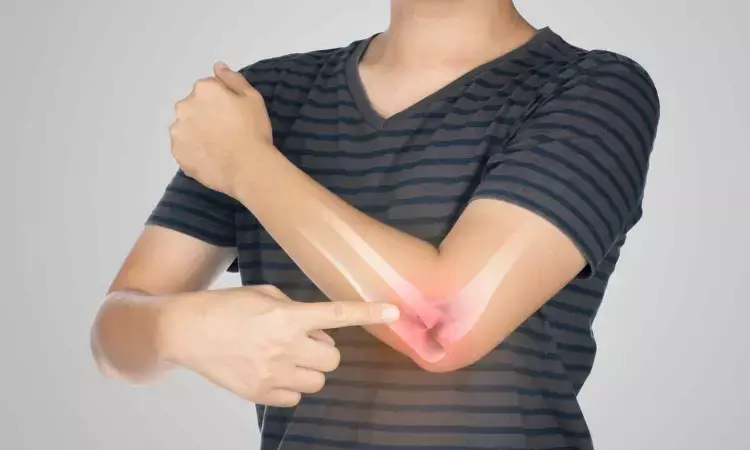- Home
- Medical news & Guidelines
- Anesthesiology
- Cardiology and CTVS
- Critical Care
- Dentistry
- Dermatology
- Diabetes and Endocrinology
- ENT
- Gastroenterology
- Medicine
- Nephrology
- Neurology
- Obstretics-Gynaecology
- Oncology
- Ophthalmology
- Orthopaedics
- Pediatrics-Neonatology
- Psychiatry
- Pulmonology
- Radiology
- Surgery
- Urology
- Laboratory Medicine
- Diet
- Nursing
- Paramedical
- Physiotherapy
- Health news
- Fact Check
- Bone Health Fact Check
- Brain Health Fact Check
- Cancer Related Fact Check
- Child Care Fact Check
- Dental and oral health fact check
- Diabetes and metabolic health fact check
- Diet and Nutrition Fact Check
- Eye and ENT Care Fact Check
- Fitness fact check
- Gut health fact check
- Heart health fact check
- Kidney health fact check
- Medical education fact check
- Men's health fact check
- Respiratory fact check
- Skin and hair care fact check
- Vaccine and Immunization fact check
- Women's health fact check
- AYUSH
- State News
- Andaman and Nicobar Islands
- Andhra Pradesh
- Arunachal Pradesh
- Assam
- Bihar
- Chandigarh
- Chattisgarh
- Dadra and Nagar Haveli
- Daman and Diu
- Delhi
- Goa
- Gujarat
- Haryana
- Himachal Pradesh
- Jammu & Kashmir
- Jharkhand
- Karnataka
- Kerala
- Ladakh
- Lakshadweep
- Madhya Pradesh
- Maharashtra
- Manipur
- Meghalaya
- Mizoram
- Nagaland
- Odisha
- Puducherry
- Punjab
- Rajasthan
- Sikkim
- Tamil Nadu
- Telangana
- Tripura
- Uttar Pradesh
- Uttrakhand
- West Bengal
- Medical Education
- Industry
Cast immobilization effective in treating pediatric medial epicondyle fractures: JAMA

A new study published in the Journal of American Medical Association showed that casting by itself was just as successful as surgery in treating youngsters with medial epicondyle fractures.
A fall on an outstretched hand usually causes medial humeral epicondyle fractures, which account for 12% to 20% of all pediatric elbow fractures and have an incidence of three or more per 100,000 children. With the exception of situations in which the fragment becomes lodged in the elbow joint, when surgery is usually advised, there is presently little agreement on how to treat displaced medial epicondyle fractures in children.
Traditional nonoperative treatment for displaced children's medial humeral epicondyle fractures involves casting. Nevertheless, even though there is little high-level data to support the benefits of surgery, its usage has expanded. Thus, to ascertain if open surgical reduction and internal fixation, as opposed to extended arm casting, enhance functional outcomes in children with displaced medial humeral epicondyle fractures at 12 months post-injury, Petra Grahn and team carried out this study.
Between August 30, 2019, and August 22, 2023, four university hospitals in Finland participated in this noninferiority randomized clinical study. A 12-month follow-up was finished on August 20, 2024. Children (ages 7–16) with medial humeral epicondyle fractures that were not imprisoned and that had more than 2 mm of displacement were among the participants. Intention to treat served as the foundation for data analysis. The Quick Disabilities of the Arm, Shoulder, and Hand (QDASH) score at 12 months was the main result.
A total of 37 patients (19 [51.4%] female) were randomly assigned to the surgery group, while 35 patients (24 [68.6%] female) were assigned to the cast group. The surgery group's mean QDASH score at 12 months was 1.73, whereas the cast group's was 2.71, indicating noninferiority.
There was a statistically significant difference of −8.9 points between the cast group and the other group on the cosmetic visual analog scale. Nearly, 24 out of 35 patients who had cast treatment (68.6%) and 1 out of 37 patients who received surgery (2.7%) experienced nonunion. There were no crossovers from casting to surgery.
Overall, for pediatric patients with displaced humeral medial epicondyle fractures, internal fixation and open reduction were not inferior to casting without reduction. Future research should evaluate long-term results throughout adolescence, especially elbow function under load and late instability, even if this experiment offers compelling evidence for one year.
Source:
Grahn, P., Helenius, I., Hämäläinen, T., Kivisaari, R., Nietosvaara, Y., Sinikumpu, J.-J., Jalkanen, J., Löyttyniemi, E., Ahonen, M., & Finnish Pediatric Orthopedic Study Group Investigators. (2025). Casting vs surgical treatment of children with medial epicondyle fractures: A randomized clinical trial. JAMA Network Open, 8(5), e258479. https://doi.org/10.1001/jamanetworkopen.2025.8479
Neuroscience Masters graduate
Jacinthlyn Sylvia, a Neuroscience Master's graduate from Chennai has worked extensively in deciphering the neurobiology of cognition and motor control in aging. She also has spread-out exposure to Neurosurgery from her Bachelor’s. She is currently involved in active Neuro-Oncology research. She is an upcoming neuroscientist with a fiery passion for writing. Her news cover at Medical Dialogues feature recent discoveries and updates from the healthcare and biomedical research fields. She can be reached at editorial@medicaldialogues.in
Dr Kamal Kant Kohli-MBBS, DTCD- a chest specialist with more than 30 years of practice and a flair for writing clinical articles, Dr Kamal Kant Kohli joined Medical Dialogues as a Chief Editor of Medical News. Besides writing articles, as an editor, he proofreads and verifies all the medical content published on Medical Dialogues including those coming from journals, studies,medical conferences,guidelines etc. Email: drkohli@medicaldialogues.in. Contact no. 011-43720751


